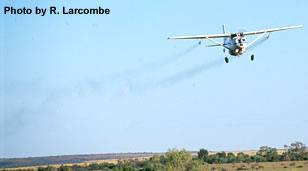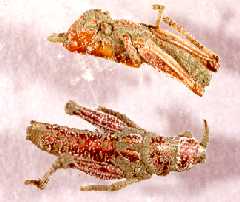The APLC control operations are designed to manage outbreaks or potential outbreaks of the Australian plague, spur-throated and migratory locusts which, in the opinion of the commission, represent a credible threat of damage to rural industries in more than one Member State. Protection of crops is not the responsibility of the commission, although on occasion that may occur as a consequence of controlling a significant band or swarm.
The objective is to reduce the impact of major locust infestations by early intervention during the breeding sequences that result in large population increases. Regular field surveys are conducted to identify infestations which if uncontrolled may lead to large population increases and migration to other areas. While locusts may be present over a considerable area during an outbreak, a major part of the population will be concentrated in high density bands of nymphs (hopper bands) and adult swarms which can be located and controlled from aircraft.
[expand all]
APLC Control

The principal method of control is to aerially spray bands or swarms with one of three currently registered insecticides. These insecticides are applied by aerial agricultural operators under contract to the APLC using fixed wing aircraft fitted with Micronair rotary atomiser application equipment. Differential Global Positioning System (DGPS) navigation equipment is fitted to spray aircraft to ensure the precise application of insecticide. Information on the location of control activities is provided to stakeholders and the public through regular Locust Management Advice.
The insecticides currently used are the the organophosphorous insecticide - fenitrothion, the phenyl pyrazole insecticide - fipronil and the bio-pesticide – Green Guard, or Metarhizium acridum. Information on the use, label restrictions and effects of these insecticides is provided on the Locust control agents-livestock and crop residues page.
Spraying of locusts by the APLC is carried out with due regard to health, safety and the environment. Before a control campaign is mounted a number of criteria must be met, taking into consideration the size and location of an infestation, safety hazards and environmental constraints. The APLC does not, in accordance with strict national regulations on aerial spraying, spray over homesteads, vehicles, stock or dams, or within five km of beehives or crops being pollinated by bees. Spraying is only carried out with the permission of landholders.
APLC locust control operations are designed to have minimal impact on the environment. The Environment Research and Monitoring program addresses potential impacts of APLC control on non-target animals and the environment.
The APLC does not undertake any control with ground-based equipment, as a far greater number of locusts can be sprayed in a short period of time with aerial spraying. However, opportunities for aerial spraying may be limited by the requirements to leave buffer zones around waterways and homesteads, particularly in more closely settled areas. It is therefore important that landholders and other stakeholder agencies undertake ground control where bands of nymphs are small or not dense enough to be seen from the air, present a direct threat to crops, or are within 1.5 km of homesteads and waterways where aerial spraying may not be possible.
Aerial Spraying
Rotary atomisers create very fine droplets of insecticide, allowing ultra-low volume (ULV) insecticide formulations to be used for locusts. The standard rate of application for controlling bands and swarms of the Australian plague locust is 210-300 mL of fenitrothion per hectare (dose of 267-381 g ai/ha) or 300 mL of fipronil per hectare (0.9 g ai/ha). The volume of fipronilis further reduced through barrier treatments, which control nymphs as they move through narrow strips of pesticide-treated vegetation.
Bio-pesticide Control

The APLC, in collaboration with CSIRO Entomology, developed a non-chemical method of locust control that utilises a naturally occurring fungus called Metarhizium acridium.Fungal spores suspended in a mineral or vegetable oil are sprayed onto locusts using conventional spraying equipment.
This fungus only attacks locusts and grasshoppers and is harmless to most other organisms. It has primarily been used in areas where land use limitations restrict the use of other insecticides.